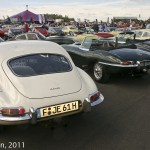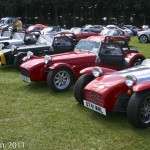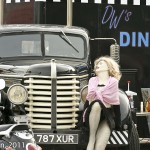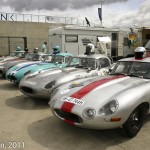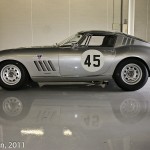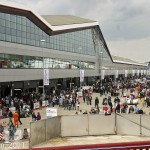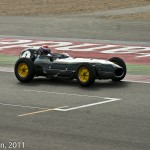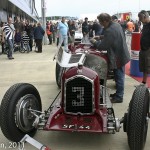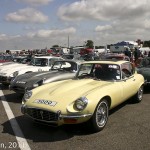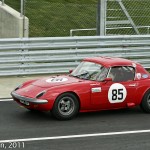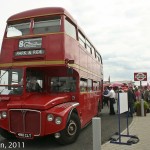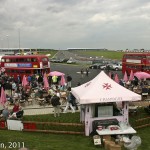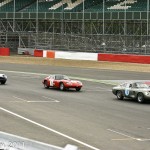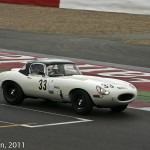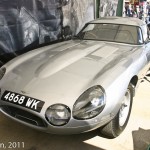Silverstone Classic
Is biggest necessarily best?
The organisers of this year’s Silverstone Classic were proudly boasting that theirs was the biggest race meeting ever. With nigh on 1,000 contestants and 800 cars taking part they were probably right. Add to that something like 7,000 classic cars on site, almost 1,000 of which were E-Type Jaguars. But can you have too much of a good thing?
Some 80,000 fans descended upon the circuit, contributing to huge traffic jams building-up on the A43, entry into the circuit being slow as all those classics needed to be directed to their allotted parking area in what was a very crowded site. Not all of them made it that far even, as reports were coming in on Saturday of up to 100 E-Types having suffered overheating and other breakdowns en route.
Having made it into the circuit there was a lot to see and do. The competitors were split between two paddock areas, the impressive new Silverstone ‘Wing’ acting as home to many whilst others were based in the old paddock at the opposite end of the circuit. That was something of a logistical nightmare for teams with cars based in both paddocks, especially as the only means of getting from one to the other was via Routemaster ‘bus – nothing wrong with that, the buses were run very efficiently but with the sheer number of people, queues and delays inevitably built up and some very unfriendly security operatives would not allow you to walk between the two areas.
Well, with the gripes out of the way, how was the racing? Pretty good actually, with some close and exciting action, most classes getting two races each. The revised circuit was new to many so that was just as well, as even seasoned hands such as former BTCC Champion John Cleland were having to find their way around. Cleland was driving in the Jaguar E-Type Celebration race and got taken by surprise as he turned into the new-look Abbey for the first time – “where did tha-at come from? said the ever quotable Scot afterwards. Didn’t stop him from winning his class for near standard cars though. Jon Minshaw’s well-developed car (even been in a wind tunnel, allegedly) was the outright winner of both races. Such is the value of genuine original E-Type’s that many of the modified cars in this anniversary series of races have been specially built; they’ve still cost their owners six-figure sums however…
Group C got star billing with the first of their races being run as an ‘into the twilight’ affair on Saturday evening. Both Alex Buncombe (Jaguar XJR9) and Katsu Kubota (Nissan R90C) got the jump on Gareth Evans’ Mercedes C11 on the run down to the first corner and set off on a race-long battle over 15 laps. After swapping places several times Kubota led at the most important moment as they crossed the line, Buncombe having briefly been delayed by a backmarker whilst the Merc recovered to finish third.
If Saturday’s race was fast and furious Sunday’s affair was even more so. With Bob Berridge now in the Mercedes and Japanese F3 racer Hideki Yamauchi on board the Nissan the wick was really turned up – and remember these cars are now unfettered by the period fuel limitations – and again we were treated to a see-saw race as they swapped places but this time it was the turn of the Nissan to fall foul of lapped cars late in the race, handing the win to Berridge, such was the pace that they completed one more lap in the available time than had been managed the night before. Even so, a remarkable drive by Andy Meyrick saw his C2 Spice take the final podium spot.
Meyrick showed his versatility by taking both Grand Prix Masters counters too in his March 761. It was another version of the 761, built locally in Bicester that was grabbing much of the attention however. Jeremy Smith was giving the six-wheel March 2-4-0 its first ever race. Originally conceived for the 1977 season, it never actually raced in period although it was subsequently hill-climbed. Unlike the Tyrrell P34, the March featured an extra pair of wheels at the back with smaller tyres than normal, thus reducing the drag. However, March was strapped for cash at the time and was unable to afford the sufficiently robust transmission casing needed to carry drive to the rearward wheels. The affair they did create actually twisted and damaged the internals on a short press demo run, so it was quietly put away. However, according to Mike Lawrence in his excellent history of March it turned out eventually to be their most profitable F1 car as they sold the rights to Scalextric!
Other excitement at Silverstone was provided by such varied machinery as Formula Junior, Under Two Litre Touring Cars (U2TC) and the RAC TT for Pre ’63 GT cars. In the latter Stuart Graham and Richard Attwood stole a lucky win on the very last lap in their Aston Martin DB4 when the leading Ferrari 250 GT crewed by Hans Hugenholtz and David Hart expired. U2TC went to the Leo Voyazides/Simon Hadfield Lotus Cortina after a nail-biting battle with the similar car of Howard Redhouse/Mike Jordan and the Jackie Oliver/Richard Shaw BMW. In shades of days of old we even had a TWO-wheeling Cortina at one point! Often overlooked, the FJ tiddlers were thrilling with race wins going to Sam Wilson and Jon Milicevic, both Cooper T59-mounted.
Of course there was so much more to see with small sports cars and big saloons (where do all those V8 Fords come from?). Not all the Mustangs were on the ground either, for one took part in an air display together with a Spitfire. Amongst all the other anniversaries being marked this year, mustn’t forget that RJ Mitchell’s truly iconic design is 75.
Despite our opening comments, Nick Wigley and his team are to be congratulated for pulling together such a massive event but just sometimes less is more.
John Elwin, August 2011
- Optimist – only 1000 turned up
- John Minshaw’s E-Type

